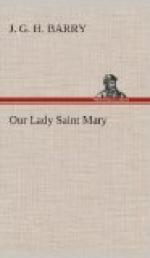Her face a heaven; two planets
were her eyes,
Whose gracious light did make our clearest
day;
But one such heaven there was, and lo, it dies,
Death’s dark eclipse hath dimmed every,
ray:
Sun, hide thy light, thy beams untimely shine;
True light since we have lost, we crave not
thine.
Robert Southwell, 1560-1595
PART TWO
CHAPTER XXV
THE ASSUMPTION
Father, I will that
they also, whom thou hast given me, be with
me where I am; that
they may behold my glory, which thou hast
given me.
S. John XVII, 24.
Hail! Holy Queen, Mother of mercy, hail! Our life, our sweetness, our hope, all hail. To thee we cry, poor exiled children of Eve. To thee we send up our cries, weeping and mourning in this vale of tears. Turn, then, Most gracious Advocate, thy merciful eyes upon us, and now, after this our exile, show unto us the blessed Fruit of thy womb, Jesus. O gracious, O merciful, O sweet Virgin Mary. Anthem from the breviary. Attributed to Hermann Contractus, 1013-54.
There is nothing more wonderful or beautiful, nothing that brings to us a more perfect revelation of our Lord’s mind, than this prayer which is recorded for us by S. John. There is in it a complete unfolding of that sympathy and love which we feel to underlie and explain our Lord’s mission. As we come to know what God is only when we see Him revealed in Jesus; when we enter into our Lord’s saying, “He that hath seen me, hath seen the Father,” so in the revelation of Jesus we understand God’s attitude toward us. In Jesus the love of God shows itself, not as an abstract quality, a philosophical conception, but as a burning, passionate eagerness to rescue, an outgoing of God to individual souls. There is a deep personal affection displayed in this final scene in the Upper Chamber. This is our Lord’s real parting from His disciples. He will see them again, but under conditions of strain and tragedy, or under such changed circumstances that they cannot well enter into the old intimacy. But here there is no bar to the expression of love. Here He gives them the final evidence of His utter union with them in the humility of the foot-washing. Here He marvellously imparts Himself in the Breaking of the Bread, wherein is consummated His personal union with them. This is the demonstration, if one were needed, that having loved His own, He loved them unto the uttermost.
It is inconceivable that passionate love such as this should ever end. It is a personal relation which must endure while personality endures. It is really the demands of love which more than anything else outside revelation are the evidence of immortality. We are certain that the love of God which in its fulness has been made known in Christ cannot be annihilated by death. “I have loved thee with an everlasting




